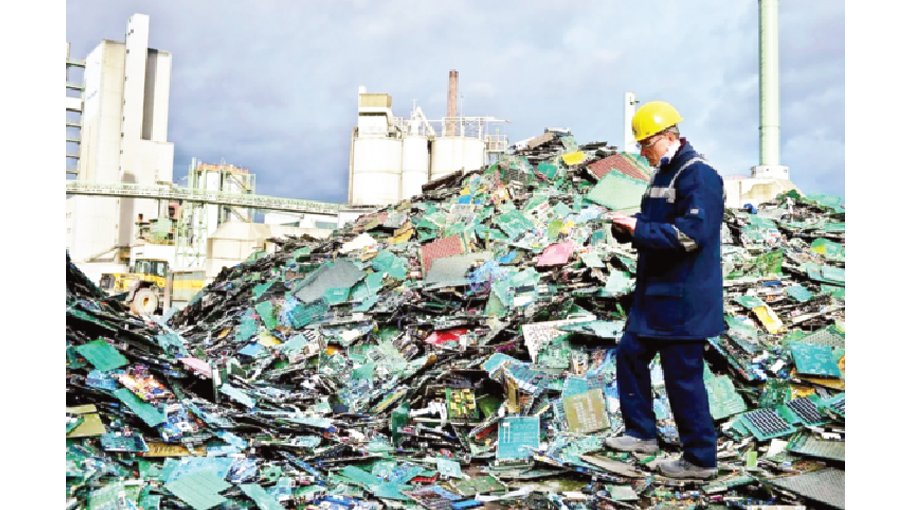E-waste poses serious threat to public health
Management policy yet to be implemented

Used or out-of-order computers, laptops, mobile phones, photocopiers, micro-owavens, batteries and other e-stuff threatens public health and environmental damages.
Due to lack of proper electronic trash management policies such pollution, generated by electronic devices, the country appears to be facing a serious health risk.
The rapidly expanding issue has also been taking a serious turn due to the lack of proper management of the associated toxic chemicals like mercury, cadmium, nickel and lead, policy makers said.
People frequently are upgrading their mobile phones, computers, televisions, audio equipment and printers.
Because of such upgrading consumers usually sell off their old items to scrap shops, and hawkers in exchange for other items like onion, plastic items and many others.
Mustafa Jabbar, Former Minister of Posts and Telecommunications of Bangladesh, told Bangladesh Post, “E-waste is a big problem for our country. Most e-waste in our country is generated from used televisions followed by mobile phones. Every house in the country is producing more or less such e-waste. But we don’t care about e-waste management.” According to BTRC statistics, the total number of cell phone subscriptions reached 190 million by the end of November 2023.
A total of 35 million mobile phone sets are sold in the country every year, according to Bangladesh Mobile Phone Importers Association.
If it was assumed these phones have a lifespan of two-three years, these phones generate an alarming amount of e-waste in the form of mercury, silicon, cadmium, lead, chromium and more.
The UN defines e-waste as any discarded product with a battery or plug, and features toxic and hazardous substances such as mercury, that can pose severe risks to human and environmental health.
According to the UN, in 2021 each person on the planet will produce on average 7.6 kg of e-waste, meaning that a massive 57.4 million tons will be generated worldwide. Only 17.4 per cent of this electronic waste, containing a mixture of harmful substances and precious materials, will be recorded as being properly collected, treated and recycled.
Recognizing the gravity of the situation, the government has enacted policies to address the risks associated with e-waste, marking a significant step forward with the Hazardous Waste (E-Waste) Management Rules, 2021.
Although the ‘e-waste management rules’ have been formulated, it has not been implemented in two years.
City corporations and municipal authorities are not even aware of electronic and electrical wastes being left in open spaces in the capital and elsewhere in the country every single day.
Experts expressed serious concern over such handling of e-waste containing mercury, lead, cadmium, zinc and other hazardous elements that don’t get dissolved.
At a roundtable in June last year it was informed that every year Bangladesh generates roughly 3 million metric tons of e-waste from televisions sets, computers, mobile phones, CFL bulbs, mercury bulbs, thermometers, medical and dental waste, household electrical appliances and switches. One-third of e-waste comes from smart devices.
Mustafa Jabbar said “City corporations don’t know what e-waste is. The city corporation has no idea how to manage e-waste. I have yet to see any action on e-waste in the waste management of the city corporation.”
“Many unscrupulous traders buy used laptop computers and mobile phones from abroad as scraps. It is very harmful to mankind. We do not want to be a dumping station for e-waste. This is a big threat to Bangladesh,” said the Minister.
He blamed Bangladesh customs for releasing used laptop computers and mobile phones brought from abroad.
Bangladesh sells electronic goods worth $1.36 billion while generating approximately 2.81 million tons of e-waste every year, a study revealed in October 2022.
Many harmful substances such as lead, cadmium, chromium, Brominated flame retardant, beryllium, antimony, polyvinyl chloride (PVC), mercury, arsenic, Polychlorinated biphenyl (PCB) etc mixed with soils, water and air, create a poisonous environment for humans.
These contaminated substances damage the human nervous system, blood transfusion system, kidney and reproductive system. It also causes cancer, and birth defects and disables the reproductive ability of humans. Poor children and women are the main victims of the e-waste.
Dr Rowshan Mamtaz, Professor of the Department of Civil Engineering at Bangladesh University of Engineering & Technology (BUET), said “The more dangerous thing is that these electronic wastes are being dumped alongside the regular household wastes. The level of risk is extremely high.”
“E-waste is more harmful than any common municipal waste. Without proper and safe e-waste disposal, it creates a health risk,” she said.
She said “Users dispose of electronic goods after their lifespan is over. But, unfortunately, there is no proper dumping place for the e-waste. Creating awareness about the risk of e-waste is badly needed.”
Two city corporations have no separate mechanism for disposing of e-waste, they are usually dumped with domestic wastes at the Amin Bazaar Land Fill and Matuail landfill site.
A research report has found that 80 per cent of the people who are involved in e-waste management do not know about its harmful aspects.
Abdus Sobhan, general secretary of Poribesh Bachao Andalan (POBA), said, “Most of the people don’t know about the harmful aspects of e-waste. They dumped those electronic items with their regular waste. Which is a point of great concern.”
“Heavy metals and toxic substances like mercury, lead, cadmium, zinc and chromium are being released through e-waste into the environment as well as in water bodies and croplands directly. These elements enter the human body through the food chain,” he added.
“It is important to manage e-waste properly as it is increasing every day,” he also added.



